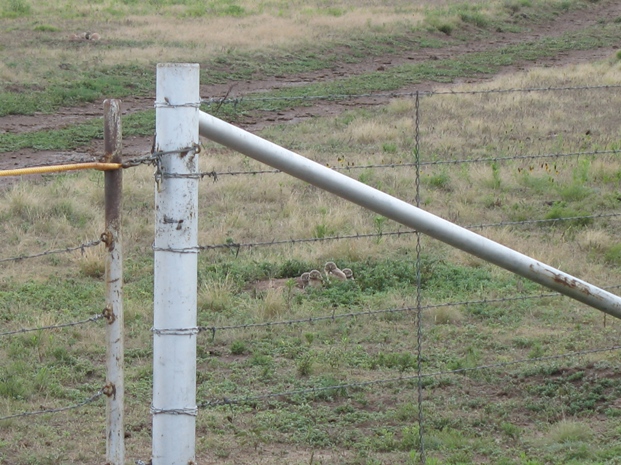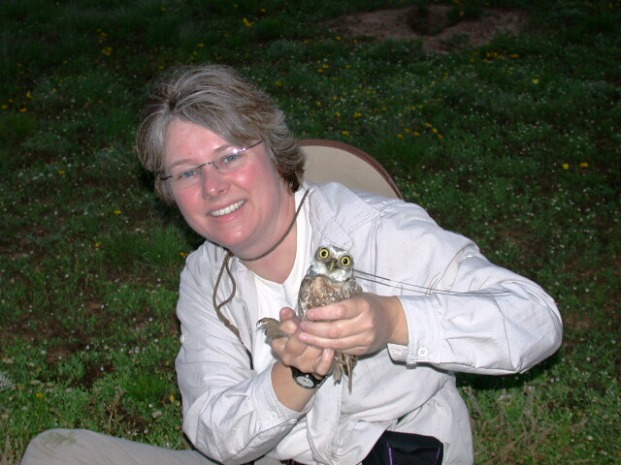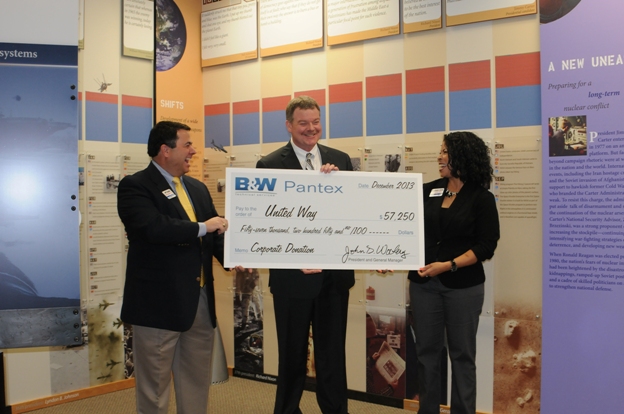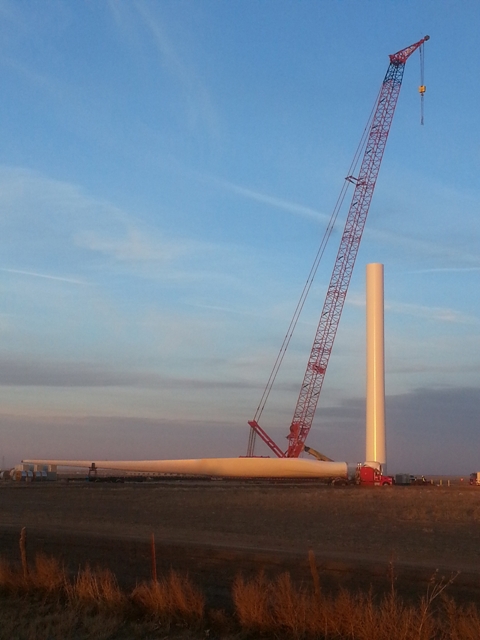Pantex Blog
Dignitaries Make Mark on Pantex Renewable Energy Project
U.S. Congressman Mac Thornberry joined local dignitaries and other visitors gathered at the Pantex Plant Thursday to make their mark on an important wind project at the Plant. The visitors joined NNSA Production Office and B&W Pantex leaders, as well as representatives from project contractor Siemens Government Technologies Inc., in signing one of the massive wind turbine blades that will become part of the Pantex Renewable Energy Project (PREP). When it is complete this spring, PREP will be the largest federally owned wind farm in the U.S. and will provide more than 60 percent of the annual electricity needs for the Plant.
The ceremony provided stakeholders an opportunity to receive an update on the project, as well as get a close-up look at the wind turbines that make up the project. Each blade weights 11 tons and is more than 150 feet long. When completed, the towers will stand over 400 feet tall at the blade tips.
Elected officials visiting the Plant included Thornberry, Texas State Sen. Kel Seliger, Texas State Legislator Four Price, Amarillo Mayor Paul Harpole and Carson County Judge Lewis Powers.
Wild Pantex – Partnering for Burrowing Owls
Article by Jim Ray, Pantex Wildlife Biologist/Scientist
Research on Western Burrowing Owls has been a major part of the body of wildlife research that has taken place over the last 14 years at Pantex. Much data has been produced through a collaboration that involved the Pantex Natural Resources staff, Texas Tech University’s departments of Biological Sciences and Natural Resources Management, and the U. S. Geological Survey’s Texas Cooperative Fish and Wildlife Research Unit at Texas Tech. Thanks to resources contributed through those external entities much of this work included study sites scattered across the Southern High Plains of Texas, thus increasing the value of the data through the scale of the research effort.
Initially, Burrowing Owls were counted by Pantex staff in conjunction with prairie dog population surveys derived from procedures conducted and published by the Rocky Mountain National Arsenal (2000-2003). Then, from 2003-2005 Pantex contracted with Texas Tech staff to study the ecology of these owls.
The density of breeding Burrowing Owls at Pantex was similar to other sites across the region, and the bigger the prairie dog colony and the more holes that were available, the more Burrowing Owls we found. Although sometimes observed in other burrow types in the Great Plains, during this study we found no Burrowing Owl nests in study plots that were outside prairie dog colonies.
Each owl pair at Pantex fledged just shy of three young per year during the study. Local prey availability, vegetation measurements, nor density of prairie dogs had any effect on density of owls or their ability to fledge young at a location. Most of the Burrowing Owls that we captured and banded during the breeding season migrated away from the region for the winter months.
We found that these owls can fare as well in close association with man, as in more rural settings. More vertebrate prey, like mice and amphibians, were taken as food at rural sites, whereas invertebrates, like insects, were taken in greater abundance in situations where the birds were nesting near human activity.
We also studied whether or not necklace-style radio transmitters could be safely worn by Burrowing Owls for research purposes. It was found that the necklaces should be used with caution, perhaps with further modifications and evaluations, as both wild and captive owls initially spent considerable time focused on the necklace instead of watching for potential predators. However, the owls habituated to the necklaces relatively quickly, and survival was not affected.
The collaboration on Burrowing Owls with Tech has involved several students and resulted in two M.S. theses (Teaschner 2005, Chipman 2006). To date, two peer-reviewed scientific publications (radio-necklaces, land-use) have resulted from the work, and a popular article has recently been accepted to be published in Bird Watcher's Digest. Seven presentations on the work have been made at state, national, and international conferences, and even more at meetings characterized as less technical in nature.
Today, West Texas A&M University collaborators collect bird data in plots within prairie dog colonies at Pantex in association with wind energy research, thus monitoring of Burrowing Owls continues at Pantex. Mapping of prairie dog colonies is an annual management activity, thus Burrowing Owl habitat availability is monitored.

Wild Pantex – Burrowing Owls
Article by Jim Ray, Pantex Wildlife Biologist/Scientist
This week I have a guest blogger, one that we have collaborated with on burrowing owl research. I will follow this up next week with more information on the research project itself.
Nancy McIntyre is Professor of Biological Sciences and Curator of Birds at Texas Tech University. She writes:
"Burrowing Owls are easy to overlook, especially when you’re traveling 55+ miles per hour. My first encounter with a Burrowing Owl was along a lonely prairie road in eastern Colorado, now 20 years ago. Recently transplanted from Georgia, I was traveling from point A to point B and marveling at the utter lack of trees, when a black-tailed prairie dog crossed the road in from of me. I slowed and realized that the road cut through an enormous prairie dog colony. Slowing further, I spotted a dumpy bird that flew from the ground to a fence post. I pulled abreast of the post, stopped, and beheld my first Burrowing Owl. I took a pair of binoculars from my glove compartment and focused them on the little guy's facial expression; one that was at once both cute and ornery. Yellow eyes glared at me with real menace, but given that their owner was less than nine inches tall, I couldn’t help but laugh out loud at the absurdity. Thus began my love affair with Burrowing Owls.
Burrowing Owls are among the most accessible owls in the world because they are diurnal and often live near human settlements. These traits are at odds with the typically secretive, nocturnal habits of other owls. Indeed, many Texans may see Burrowing Owls on a daily basis throughout much of the year and yet may never see another type of owl in their entire lives. However, many more Texans are unaware of the existence of owls so close by. Collaborations between Texas Tech University and Pantex have contributed to our understanding of their reproduction, behaviors, and habitat associations.
Burrowing Owls occur from Canada to the southern tip of South America, but they are not equally abundant over all of these regions. They are absent from forested areas, being birds of the wide open spaces of prairie and desert. And the owls do not occur in all portions of their range throughout the year: like most birds, they are migratory. Most Burrowing Owl individuals will migrate away from their summer breeding area to an overwintering location. For example, some owls that breed in Canada overwinter along the Texas coast. Burrowing Owls are primarily summer residents at Pantex, one of numerous breeding bird species that occur at the site. However, a few burrowing owls from points north can be found at Pantex during the winter.
Burrowing Owls rely upon other species to dig their burrows. Over much of the owls’ range, the primary burrow providers are black-tailed prairie dogs, which are too large to be owl prey. These colonial rodents live in “towns” of family groups in numerous burrows. Different burrows have different uses: some are nurseries whereas others are used as latrines. Many burrows may be unoccupied because of death or abandonment by residents. These empty burrows may be colonized by Burrowing Owls, where they raise 2-4 chicks, primarily on a diet of insects and small vertebrates like mice.
Listed as endangered in Canada and threatened in Mexico, the Burrowing Owl is a species of concern in the U.S. Burrowing Owls are disappearing from areas where they once occurred and are declining in most areas where they remain, primarily due to conversion of habitat for agriculture and urbanization, and especially to declines in prairie dog numbers. Construction of artificial burrows, protection of nesting sites during reproduction, and promoting appreciation of prairies and deserts and all their inhabitants will hopefully prevent our grandchildren from learning about Burrowing Owls in the same breath as the Dodo or Carolina Parakeet. These two species are no longer with us."

Photo: Dr. Nancy McIntyre and a burrowing owl.
B&W Pantex Makes Donation to United Way

B&W Pantex General Manager John Woolery, center, presents a B&W corporate donation Friday to the United Way of Amarillo and Canyon. United Way Interim Executive Director Jeff Gulde, left, and Campaign Director Stephanie Goins were on hand to receive the gift.
The $57,250 corporate donation supplements more than $650,000 pledged by Pantex employees to United Way for 2013, making Pantex one of the largest supporters of United Way in the Texas Panhandle. Woolery recognized that Pantexans “have big hearts” and are proud to give back to their communities.
First Blade Delivered to Pantex Renewable Energy Project

The first wind turbine blade is delivered to the site of the Pantex Renewable Energy Project Thursday. Work crews are beginning to erect the first of five wind turbines that will make up the PREP project. When it is completed this spring, PREP will be the largest federally owned wind farm in the country and will provide approximately 60 percent of the average annual electricity need for the Pantex Plant.
